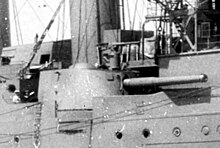
The Drake class was a four-ship class of armoured cruisers built around 1900 for the Royal Navy.

The Devonshire-class cruiser was a group of six armoured cruisers built for the Royal Navy in the first decade of the 20th century. All ships of the class served in World War I. Argyll was wrecked, and Hampshire was sunk by a naval mine. The four survivors were disposed of soon after the war.
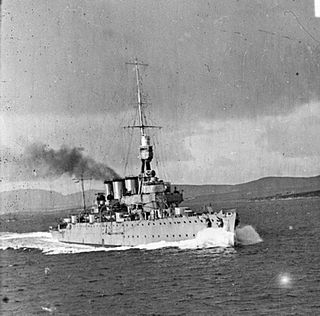
HMS Chester was a Town-class light cruiser of the Royal Navy, one of two ships forming the Birkenhead subtype. Along with sister ship, Birkenhead, she was originally ordered for the Greek Navy in 1914 and was to be named Lambros Katsonis. The order was placed with Cammell Laird and production continued for the Greek account after the outbreak of the First World War in August 1914. In 1915 the two cruisers were purchased by the British government. She fought at the Battle of Jutland where casualties included John 'Jack' Cornwell who was awarded the highest honour, aged 16.

The Eclipse-class cruisers were a class of nine second-class protected cruisers constructed for the Royal Navy in the mid-1890s.

The Highflyer-class cruisers were a group of three second-class protected cruisers built for the Royal Navy in the late 1890s.

The 305mm/45 Modèle 1906 gun was a heavy naval gun of the French Navy.
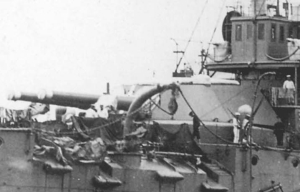
The Armstrong Whitworth 12-inch naval gun of 40 calibres length was designed by and manufactured mainly by Armstrong's ordnance branch, Elswick Ordnance Company. It was intended for the Royal Navy's Royal Sovereign-class battleships, but budgetary constraints delayed their introduction. The first units were instead supplied to Japan. As the Type 41 12-inch (305 mm) 40-calibre naval gun it was the standard main battery on several early United Kingdom-built pre-dreadnought battleships of the Imperial Japanese Navy.

The Vickers 10 inch naval gun was used on battleships and armoured cruisers built during the first decade of the 20th century. They were used as the Type 41 10-inch /45-caliber aboard the British-built semi-dreadnought Katori-class and Satsuma-class battleships of the Imperial Japanese Navy.

The 15 cm SK L/45 was a German naval gun used in World War I and World War II.
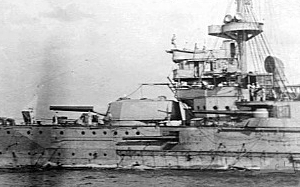
The EOC 10-inch 45 calibre gun were various similar 10-inch naval guns designed and manufactured by Elswick Ordnance Company to equip ships they built and/or armed for several countries before World War I.

The 15 cm/50 41st Year Type gun was a naval gun used by the Imperial Japanese Navy before and during World War II. It had a 152 millimetres (6.0 in) bore with a length of 7.6 metres (25 ft) and fired 45.4 kilograms (100 lb) shell for a distance of 18,000 metres (20,000 yd) or 21,000 metres (23,000 yd). The gun was first used in single casemates on the Kongō-class battlecruisers and Fusō-class battleships and later in the Agano-class light cruisers in twin mountings.

The Challenger-class cruisers were a pair of second-class protected cruisers built for the Royal Navy in the first decade of the 20th century. One ship, HMS Encounter, was later transferred to the Royal Australian Navy.
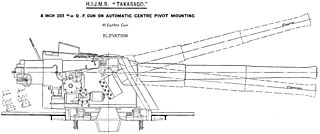
The 20.3 cm/45 Type 41 naval gun was a Japanese naval and coast-defense gun used on cruisers of the Imperial Japanese Navy from the Russo-Japanese War through the end of World War II.
The QF 14-pounder Mk I & II was a 3-inch high-velocity naval gun used to equip battleships for defence against torpedo boats. It was produced for export by Elswick Ordnance Company and Vickers, Sons and Maxim. In Royal Navy service they were modified to use the standard 12-pounder shell, while the Italian Regia Marina used the original 14-pounder shells.

The 16"/45 caliber gun was used for the main batteries of the last class of Standard-type battleships for the United States Navy, the Colorado-class. These guns promised twice the muzzle energy over the Mark 7 12-inch/50 caliber guns of the Wyoming-class battleship and a 50% increase over the 14-inch/45 caliber guns of the New York-class, Nevada-class, and Pennsylvania-class battleships.

The Cannon 102/45 was a naval gun of the Italian Navy in World War II, which was later modified for shore based anti-aircraft and coastal artillery roles.
The EOC 8 inch 40 caliber were a family of related 8 in (200 mm) 40 caliber naval guns designed by the Elswick Ordnance Company and manufactured by Armstrong Whitworth for export customers before World War I. Users of this family of gun included the navies of Chile and Portugal.
The BL 13.5-inch Mk VI gun was a British heavy naval gun, originally ordered by the Ottoman Navy to equip its Reşadiye-class dreadnoughts around 1911. The one ship completed was seized by the British Government when World War I began in August 1914 and became HMS Erin. Only 10 guns were built, to a design similar to that of their 45-calibre BL 13.5-inch Mk V naval gun. The smaller chamber in the Mk VI gun meant that less propellant could be used which reduced muzzle velocity by 55 ft/s (17 m/s) and range by 630 yards (580 m). Designed by Vickers, they manufactured the guns of X and Y turrets, while Elswick Ordnance Company manufactured the guns of A, B, and Q turrets.

Yayoi (弥生) was one of 32 Kamikaze-class destroyers built for the Imperial Japanese Navy (IJN) in the first decade of the 20th century.

Ushio (潮) was one of 32 Kamikaze-class destroyers built for the Imperial Japanese Navy (IJN) in the first decade of the 20th century.
